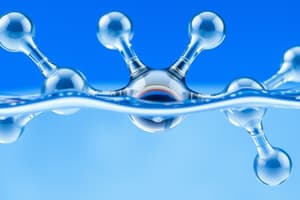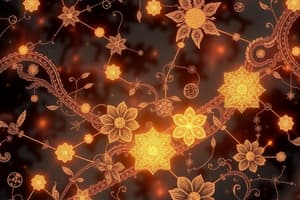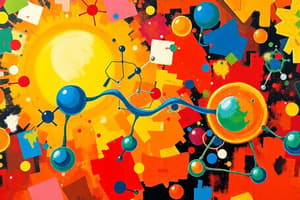Podcast
Questions and Answers
What is the primary force holding ions together in a crystal of salt?
What is the primary force holding ions together in a crystal of salt?
- Attraction between the positive and negative ions. (correct)
- Covalent bonds formed by electron sharing.
- Dipole-dipole interactions between polar molecules.
- Intermolecular forces between neutral atoms.
Which of the following best describes the structure of a salt crystal?
Which of the following best describes the structure of a salt crystal?
- A random assortment of ions and atoms.
- A three-dimensional lattice of cations and anions. (correct)
- A collection of covalently bonded molecules.
- A two-dimensional arrangement of dipole-dipole interactions.
How does bond formation differ between sodium chloride and chlorine gas?
How does bond formation differ between sodium chloride and chlorine gas?
- Sodium chloride is categorized by dipole-dipole interactions whereas chlorine gas is formed from an ionic bond.
- Sodium chloride involves the formation of ions whereas chlorine gas involves the sharing of electrons. (correct)
- Sodium chloride is formed by intermolecular forces whereas chlorine gas is formed by a 3d lattice.
- Sodium chloride involves electron sharing whereas chlorine gas involves electron transfer.
What is a characteristic of dipole-dipole interactions?
What is a characteristic of dipole-dipole interactions?
Why are the attractions between polar molecules represented by dotted lines?
Why are the attractions between polar molecules represented by dotted lines?
What primarily determines the behavior and function of molecules in organisms?
What primarily determines the behavior and function of molecules in organisms?
Which of the following statements best describes the nature of a covalent bond?
Which of the following statements best describes the nature of a covalent bond?
Why do atoms form chemical bonds?
Why do atoms form chemical bonds?
Which of the following is an example of an intramolecular bond?
Which of the following is an example of an intramolecular bond?
Based on the context provided, which elements are most abundantly found in organisms?
Based on the context provided, which elements are most abundantly found in organisms?
What is a key characteristic of atoms with incomplete valence shells?
What is a key characteristic of atoms with incomplete valence shells?
What does a red dot, shown in the subset of the periodic table, represent in the context of valence shells?
What does a red dot, shown in the subset of the periodic table, represent in the context of valence shells?
What is the primary outcome when atoms form a chemical bond?
What is the primary outcome when atoms form a chemical bond?
In a water molecule, what type of bond exists between oxygen and hydrogen?
In a water molecule, what type of bond exists between oxygen and hydrogen?
What is the primary reason oxygen develops a partial negative charge (δ-) in a water molecule?
What is the primary reason oxygen develops a partial negative charge (δ-) in a water molecule?
What is the defining characteristic of an ionic bond formation?
What is the defining characteristic of an ionic bond formation?
If the electronegativity difference between two atoms is 2.2, what type of bond would likely form?
If the electronegativity difference between two atoms is 2.2, what type of bond would likely form?
Which ion is formed when a sodium atom loses an electron?
Which ion is formed when a sodium atom loses an electron?
Which atom in Sodium Chloride (NaCl) forms an anion?
Which atom in Sodium Chloride (NaCl) forms an anion?
What has to be true for a molecule to be considered polar?
What has to be true for a molecule to be considered polar?
What is the fundamental force that holds an electron in its orbital within a single hydrogen atom?
What is the fundamental force that holds an electron in its orbital within a single hydrogen atom?
In the formation of a hydrogen molecule (H2), what causes the two hydrogen atoms to bond together?
In the formation of a hydrogen molecule (H2), what causes the two hydrogen atoms to bond together?
What is the primary difference between a polar covalent bond and an ionic bond?
What is the primary difference between a polar covalent bond and an ionic bond?
What is the term for the sharing of electrons between two atoms, typically resulting in a stable molecule?
What is the term for the sharing of electrons between two atoms, typically resulting in a stable molecule?
What is electronegativity (EN) a measure of?
What is electronegativity (EN) a measure of?
If two atoms have very similar electronegativity (EN) values, how will their sharing of electrons most likely be?
If two atoms have very similar electronegativity (EN) values, how will their sharing of electrons most likely be?
In a water molecule (H2O), why are shared electrons pulled more toward the oxygen atom than toward the hydrogen atoms?
In a water molecule (H2O), why are shared electrons pulled more toward the oxygen atom than toward the hydrogen atoms?
In water molecule (H2O), due to oxygen being more electronegative than hydrogen, what type of charge is created on the oxygen atom?
In water molecule (H2O), due to oxygen being more electronegative than hydrogen, what type of charge is created on the oxygen atom?
In water (H2O), due to oxygen being more electronegative than hydrogen, what type of charge is created on the hydrogen atoms?
In water (H2O), due to oxygen being more electronegative than hydrogen, what type of charge is created on the hydrogen atoms?
What type of bond is formed between a hydrogen atom of one water molecule and an oxygen atom of another water molecule?
What type of bond is formed between a hydrogen atom of one water molecule and an oxygen atom of another water molecule?
Which of these is essential for the formation of a hydrogen bond?
Which of these is essential for the formation of a hydrogen bond?
What term describes the interaction between water molecules and ions?
What term describes the interaction between water molecules and ions?
What happens when nonpolar molecules are placed in a polar environment like water?
What happens when nonpolar molecules are placed in a polar environment like water?
Which of the following is an example of a molecule that participates in hydrogen bonding?
Which of the following is an example of a molecule that participates in hydrogen bonding?
What characteristic defines a molecule involved in hydrophobic interactions?
What characteristic defines a molecule involved in hydrophobic interactions?
Which is a characteristic of the interaction between hydrogen and the electronegative atom (e.g. O, N or F) in a hydrogen bond?
Which is a characteristic of the interaction between hydrogen and the electronegative atom (e.g. O, N or F) in a hydrogen bond?
What term describes the phenomenon where water molecules surround ions within water?
What term describes the phenomenon where water molecules surround ions within water?
What primarily holds hydrophobic molecules together when they are placed in water?
What primarily holds hydrophobic molecules together when they are placed in water?
Van der Waals interactions can be described as:
Van der Waals interactions can be described as:
What determines how biological molecules recognize and respond to one another?
What determines how biological molecules recognize and respond to one another?
Why can molecules with similar shapes have similar biological effects?
Why can molecules with similar shapes have similar biological effects?
What feature of geckos allows them to climb walls?
What feature of geckos allows them to climb walls?
Which of these options is true about molecular shape?
Which of these options is true about molecular shape?
Morphine, designed to mimic natural endorphins, affects cells by:
Morphine, designed to mimic natural endorphins, affects cells by:
Which of the following statements best describes the relationship between molecular shape and biological function?
Which of the following statements best describes the relationship between molecular shape and biological function?
Flashcards
Atom
Atom
The smallest unit of an element that retains the chemical properties of that element.
Valence shell
Valence shell
The outermost electron shell of an atom, which contains the electrons involved in chemical bonding.
Covalent bond
Covalent bond
A strong attraction between atoms that results from the sharing of electrons.
Intramolecular bond
Intramolecular bond
Signup and view all the flashcards
Nonpolar covalent bond
Nonpolar covalent bond
Signup and view all the flashcards
Polar covalent bond
Polar covalent bond
Signup and view all the flashcards
Electronegativity
Electronegativity
Signup and view all the flashcards
Chemical bonding
Chemical bonding
Signup and view all the flashcards
Hydrogen Molecule (H2)
Hydrogen Molecule (H2)
Signup and view all the flashcards
Polar Molecule
Polar Molecule
Signup and view all the flashcards
Electronegativity Difference and Bond Type
Electronegativity Difference and Bond Type
Signup and view all the flashcards
Valence
Valence
Signup and view all the flashcards
Ionic compounds
Ionic compounds
Signup and view all the flashcards
Salt
Salt
Signup and view all the flashcards
Crystal structure
Crystal structure
Signup and view all the flashcards
Dipole-dipole interaction
Dipole-dipole interaction
Signup and view all the flashcards
Intermolecular forces
Intermolecular forces
Signup and view all the flashcards
Electronegativity (EN)
Electronegativity (EN)
Signup and view all the flashcards
Ionic Bond
Ionic Bond
Signup and view all the flashcards
Cation
Cation
Signup and view all the flashcards
Anion
Anion
Signup and view all the flashcards
Electronegativity Difference
Electronegativity Difference
Signup and view all the flashcards
Hydrogen Bond
Hydrogen Bond
Signup and view all the flashcards
Ion-Dipole Interaction
Ion-Dipole Interaction
Signup and view all the flashcards
Hydrophobic Interaction
Hydrophobic Interaction
Signup and view all the flashcards
Van der Waals Interactions
Van der Waals Interactions
Signup and view all the flashcards
Molecular Shape and Binding
Molecular Shape and Binding
Signup and view all the flashcards
Molecular Shape and Cell Function
Molecular Shape and Cell Function
Signup and view all the flashcards
Molecular Mimicry
Molecular Mimicry
Signup and view all the flashcards
Drug Design and Molecular Mimicry
Drug Design and Molecular Mimicry
Signup and view all the flashcards
Endorphin
Endorphin
Signup and view all the flashcards
Morphine
Morphine
Signup and view all the flashcards
Study Notes
Chemical Bonds
- Chemical bonds are attractions that hold two things together.
- Bonding is fundamental to biology, affecting how molecules interact in cells.
Background Chemistry
- Matter is composed of elements (in pure form) and compounds (combinations of elements).
- An element's properties are determined by the structure of its atoms.
Learning Outcomes
- Chemical structure influences the behavior and function of molecules in organisms.
- Biological molecules are constructed with specific atoms (C, H, O, N, S, P) through covalent bonds, including polar and nonpolar covalent bonds.
- Covalent bonds involve sharing electrons, contrasting with non-covalent bonds (ionic, hydrogen, hydrophobic, and van der Waals).
- Polar molecules can form hydrogen bonds, while nonpolar molecules cannot.
Covalent and Non-Covalent Bonds
- Covalent Bonds: Form from shared electron pairs. The range of covalent bond energies is approximately 50–110 kcal/mol.
- Hydrogen Bonds: Result from the sharing of a hydrogen atom, exhibiting energies from 3–7 kcal/mol.
- Ionic Bonds: Form through the attraction of opposite charges, often ranging from 3–7 kcal/mol.
- Hydrophobic Interactions: Form between nonpolar substances in the presence of polar substances; energy is approximately 1–2 kcal/mol.
- Van der Waals Interactions: Result from interactions of electrons of nonpolar substances; energy is approximately 1 kcal/mol.
Periodic Table Summary
- The highlighted elements on the periodic table are the most abundant in organisms.
- Atoms with incomplete valence shells often interact to form bonds.
- Atoms are most stable when their valence shells are full. This is usually when they have 8 electrons in the outermost shell.
- Unpaired valence electrons are shown in red.
Covalent Bonds (Intramolecular)
- Covalent bonds form between atoms within a molecule.
- Examples include ammonia (NH3) and methane (CH4).
Formation of a Hydrogen Molecule (H2)
- Hydrogen atoms share electrons to form a stable molecule.
- This sharing of electrons is a covalent bond.
- The electrons are shared equally.
Electronegativity (EN)
- Electronegativity (EN) is a measure of an atom's ability to attract electrons in a chemical bond (Pauling and Mulliken scales).
- Atoms with higher EN values attract electrons more strongly.
- Similar EN values lead to equal electron sharing.
Polar Covalent Bonds
- Polar covalent bonds result when atoms in a bond have differing EN values, leading to uneven electron sharing.
- Oxygen pulls electrons towards it more than hydrogen in a water molecule.
Polar Covalent Bonds in Water (H2O)
- Oxygen in water is more electronegative than Hydrogen, drawing shared electrons towards it.
- This creates partial charges (δ− for oxygen, δ+ for hydrogen).
- Water is a polar molecule.
Water Molecule (H2O)
- The oxygen in a water molecule (H2O) has a higher electronegativity than the hydrogen atoms.
- This creates partial positive and negative charges in the molecule.
Ionic Bonding
- Ionic bonding occurs when the difference in electronegativity between two atoms is large enough that one atom essentially transfers an electron to the other.
- This results in positively and negatively charged ions (cations and anions).
- A strong attraction between these oppositely charged ions forms an ionic bond.
- Example, Sodium Chloride (NaCl)
Ionic Compounds (Salts)
- Ionic compounds formed through ionic bonds are often referred to as salts.
- Salts may crystallize, forming a 3-dimensional lattice structure.
Differences in Bonds
- Bonds between Na+ and Cl− differ fundamentally from bonds between two Cl atoms.
Dipole-Dipole Interactions
- Dipole-dipole interactions occur between polar molecules.
- Attraction occurs between positive and negative partial charges of different molecules.
- Dotted lines denote weaker attraction; these bonds form and break easily.
Hydrogen Bonds
- A specific type of dipole-dipole interaction, occurring between a hydrogen atom bonded to a highly electronegative atom (O, N, or F) and another highly electronegative atom.
- Important for the properties of water and biological molecules.
Ion-Dipole Interactions
- Attractive forces between ions and polar molecules.
- Water molecules orient themselves to interact with positive and negative ions.
- This interaction is known as hydration.
Hydrophobic Interactions
- Forces that cause nonpolar molecules to cluster together in the presence of polar molecules like water.
- Non-polar molecules minimize their contact with water.
Van der Waals Interactions
- Weak attractive forces between all molecules, arising from temporary fluctuations in electron distribution.
- These forces are significant when molecules are very close together.
Molecular Shapes
- The shape of molecules affects how they interact in biological systems and how receptors bind to molecules.
Biological Molecules and Interactions
- Biological molecules can bind to each other temporarily if their shapes are complementary in a specific way.
- This is important for function in cells. Example, Natural endorphin and Morphine
Learning Resources
- Formation and function of molecules depends on how atoms are bonded.
Learning Objectives
- Identifying different types of bonds present in biological molecules.
- Explaining the formation of various bonds (polar and nonpolar covalent, ionic, hydrogen, hydrophobic, and van der Waals).
- Ordering bonds by strength.
- Identifying bond types for specific atom pairings (O-H, C-H, N-H, Na-Cl).
Studying That Suits You
Use AI to generate personalized quizzes and flashcards to suit your learning preferences.




